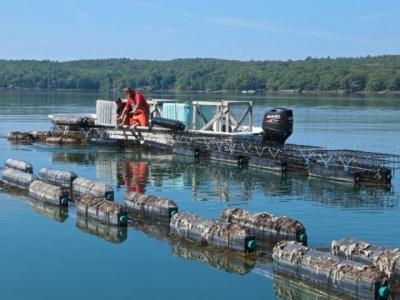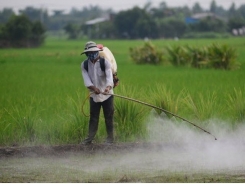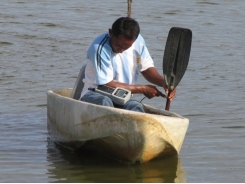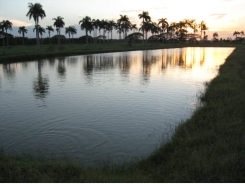Maine oyster farmer stares down climate change, learns to adapt - Part 1

Mook Sea Farm prepares for ocean acidification, shellfish farming’s existential challenge
Mook Sea Farm, on the Damariscotta River in mid-coast Maine, is adapting to risks associated with climate change. Photo courtesy of Mook Sea Farm.
Bill Mook is juggling a lot these days. He’s running Mook Sea Farm, a thriving business based on the Damariscotta River in mid-coast Maine. He’s also overseeing a project to expand and adapt his oyster farm and hatchery to a new environmental reality: It will be built to address the risks associated with climate change. He’s already seeing more frequent and intense rain storms and more acidic and warming seawater, none of which are good for growing shellfish.
As he works to raise public awareness about climate change – handling a steady stream of press, political, policy and public events – he watches for further changes in the environmental conditions affecting his farm.
Mook Sea Farm sells seed oysters to 100 growers, from North Carolina to Maine, and markets its own product under the Wiley Point and Pemaquid Point brands.
I’m pretty focused on not having all the work I’ve done for my whole career disappear because we can’t be fast on our feet.
His investments in adapting to the effects of climate change may pay off in some new opportunities to help the business thrive.
“I’m pretty focused on not having all the work I’ve done for my whole career disappear because we can’t be fast on our feet,” said Mook, who as a kid in Cooperstown, N.Y., developed a love for the marine environment while spending summers at his grandmother’s house in Rhode Island.
Mook was a graduate student in oceanography in the late 1970s before realizing he didn’t really want to be a research scientist. He got a job in a shellfish hatchery and when it folded, he was compensated with equipment that he leveraged into a new business.
In 1985, he secured leases on the Damariscotta River and founded Mook Sea Farm.
“Every problem has opportunity and that’s what it takes to be an entrepreneur – to see what those opportunities are.”
Whopping storms
On the first day of November, generators powered both Mook’s home and business during a power outage lasting several days following two severe rain storms within a week. That day, the farm could return to harvesting and shipping oysters following a five-day state closure of shellfish harvesting due to the heavy rains.
Maine automatically closes areas of its coastline to shellfish harvesting when two or more inches of rain fall in a 24-hour period to protect public health from the pollution draining watersheds into the rivers, then the Gulf of Maine. The closures typically last for three to four days.
“All the [climate change] models correctly predicted that the Northeast of the [United States] would get an increase in the very, very heavy precipitation events,” said Mook. A one-week halt to harvesting and shipping product equates to a revenue loss of about $35,000 to $50,000, he estimated.
There are more heavy rainfall events across the United States and that’s expected to continue, according to the U.S. Global Change Research Program’s Climate Science Special Report, representing the work of scientists at 13 U.S. agencies and the state of the science of climate change, with a focus on the United States.
“The largest observed changes in the United States have occurred in the Northeast,” said the report.
Heavy rainfalls and nutrient overload exacerbate the problem of ocean acidification (OA) in the Gulf of Maine, where coastal waters are more susceptible to drops in pH compared to global ocean averages. A heavy rainfall increases volume of freshwater in Maine’s rivers as they meet the coast, including in the salty Damariscotta River where Mook Sea Farm operates, which lowers the salinity and increases the acidity of coastal waters, making the water more corrosive to oysters forming shells.
In 2009, Mook first learned the effects of climate change were impacting his business, and leading to larvae losses. He met shellfish growers from Whiskey Creek in the Pacific Northwest who had lost 70 to 80 percent of their larvae before identifying a drop in pH due to upwelling.
Buffering the water by adjusting the pH did the trick – for the Pacific growers and also for Mook.
“OA was our entrée into becoming very concerned about climate change,” said Mook.
Ocean acidification tops the list of climate change effects that shellfish growers face because it can impair shellfish larvae from properly forming their shells. As oceans absorb carbon dioxide pollution from the atmosphere, seawater becomes more acidic and the pH drops.
As carbon dioxide dissolves in the water, the process binds carbonate ions and makes them less available to many of the shelled creatures that rely upon calcium carbonate to build their shells.
Once Mook began testing the pH of the Damariscotta River water for its hatchery, then treating it to be less acidic through a sophisticated water monitoring and treatment system, Mook’s oyster larvae performed near-perfectly, perhaps the first sign that investments in adaptation could benefit the business.
“Every year since then, we’ve dramatically improved hatchery production,” said Mook.

Mook Sea Farm in Maine is planning a study to help determine whether increasingly acidic seawater will harm oysters as they grow in the wild from seed to market size. Photo courtesy of Mook Sea Farm.
Related news
Tools

Phối trộn thức ăn chăn nuôi

Pha dung dịch thủy canh

Định mức cho tôm ăn

Phối trộn phân bón NPK

Xác định tỷ lệ tôm sống

Chuyển đổi đơn vị phân bón

Xác định công suất sục khí

Chuyển đổi đơn vị tôm

Tính diện tích nhà kính

Tính thể tích ao




 Maine oyster farmer stares down climate change, learns…
Maine oyster farmer stares down climate change, learns…  Factors affecting efficiency of commercial fertilizers in aquaculture
Factors affecting efficiency of commercial fertilizers in aquaculture